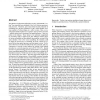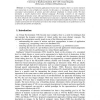81 search results - page 7 / 17 » Formation of Direction Selectivity in Natural Scene Environm... |
BC
2004
13 years 7 months ago
2004
We show that complex visual tasks, such as position- and size-invariant shape recognition and navigation in the environment, can be tackled with simple architectures generated by a...
APGV
2005
ACM
14 years 1 months ago
2005
ACM
The illusion of self-motion induced by moving visual stimuli (“vection”) has typically been attributed to low-level, bottom-up perceptual processes. Therefore, past research h...
AAI
2000
13 years 7 months ago
2000
: As Virtual Environments applications become more complex, there is a need to interpret user interaction in terms of high-level concepts. In this paper, we investigate the relatio...
JOCN
2010
13 years 6 months ago
2010
■ Selective attention confers a behavioral benefit on both perceptual and working memory (WM) performance, often attributed to top–down modulation of sensory neural processing...
LDVF
2000
13 years 7 months ago
2000
In this paper we describe Lokutor, a virtual human. Lokutor is a partially autonomous agent, inhabiting a 3D virtual environment. The agent can be controlled via natural language ...



